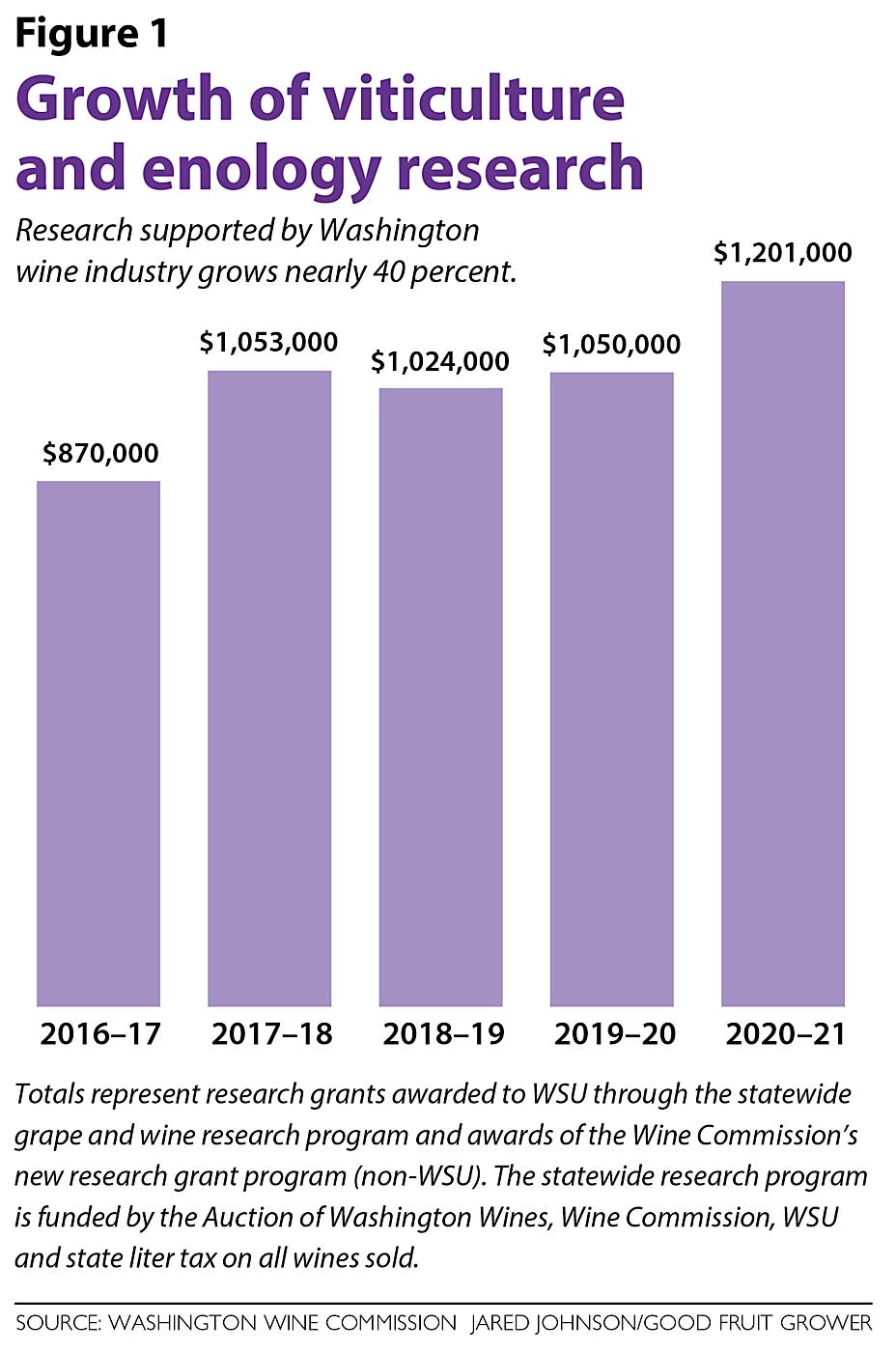The Washington wine industry, through the Washington State Wine Commission, significantly ramped up its wine research program in 2015, with the goal of making it world-class. Five years into the investment, it’s well on its way.
Key milestones include the opening of the Washington State University Wine Science Center, sustainably funding more than $1 million in research projects annually, and the creation of the industry’s own research grant program. (See Figure 1 for growth of viticulture and enology research.)

Two committees of industry volunteers dedicate their time to ensure the research outcomes and results are easily accessible to growers and wineries. This has been achieved in a variety of ways:
—To date, 130 research articles and news releases written for trade magazines, newspapers, newsletters and other media.
—More than 70 research reports archived on the Wine Commission’s website, accessible to all.
—Nearly 265 WAVE Minutes aired on Pacific Northwest AgNet (610 AM). (WAVE Minute, sponsored by the Wine Commission, is a weekly radio program featuring research news and interviews with scientists.)
Another big priority is to foster a research mindset within the industry, in part by growing participation in annual research reviews and WAVE (Washington Advancements in Viticulture and Enology) research seminars and webinars. WAVE and the condensed WAVEx seminars are jointly sponsored by WSU and the Wine Commission and have become the industry’s signature research events. More than 1,400 wine industry members attended 17 seminars and webinars by the end of 2020.
Return on investment
The most important accomplishments are the results from industry-supported research conducted by our research partner, WSU. Past research has helped growers and winemakers improve overall wine quality, reduce pesticide inputs by 80 percent and save $35 million annually, protect groundwater quality through vineyard nutrition management, conserve up to 50 percent in water through deficit irrigation, and more.
Current research projects have significant potential, including the following:
—Irrigation: Optimize irrigation for white varieties to improve wine quality; develop vineyard and winemaking tools to deal with climate change; evaluate deep root zone delivery for value in replant situations.
—Integrated pest management: Develop interim management tools for phylloxera and buy growers time before replanting on rootstock and spending $25,000 per acre to replant; develop management practices for a new grape leaffolder pest in Washington; develop tools to manage nematodes in replant situations and protect an estimated $44 million in annual replanting costs (based on a 3 percent replanting schedule for the industry’s 59,000 acres).
—Fungal and viral diseases: Develop a rapid test to help growers identify powdery mildew resistance to fungicides; evaluate ultraviolet-C light to control powdery mildew and provide an organic option, saving $2.6 million for each eliminated fungicide application; learn if grape mealybug, the vector of grapevine leafroll virus, has developed resistance to insecticides; study the use of dogs to detect leafroll virus before symptoms appear; identify location-specific factors influencing the spread of leafroll virus. (Reducing impact of leafroll virus has enormous impact: Growers can lose over $8,000 per acre over a 20-year period with just 10 percent virus infection, according to economic impact research.)
—Precision viticulture and enology: Develop both a low-cost smartphone app and sensor technology tool to estimate crop yield, saving the industry 40,000 hours of labor or $500,000 annually; develop a more precise mechanical shoot-thinning tool, with potential to save $250 per acre or an estimated $7.5 million if used on half of current acreage.
—Smoke impact on grapes and wine: Apply smoke treatments to hoop-house vineyard trials to understand early season impact; evaluate vineyard barrier sprays to reduce grape uptake of smoke-related phenols; correlate vineyard air quality to volatile phenolic levels in fruit and wine; study ash contributions on grapes and in juice to understand its role in smoke taint; develop data analysis and statistical tools for future risk modeling of smoke impact.
World-class research
WSU leadership shares the industry’s vision of creating a world-class research program and raising the bar of excellence. WSU recently took the next steps needed to elevate the viticulture and enology program to world-class status by approving:
—A four-year bachelor of science degree in viticulture and enology.
—The creation of a viticulture and enology department.
—The requirement that the last two years of the V&E program be conducted at the Tri-Cities campus at the Ste. Michelle Wine Estates WSU Wine Science Center, which is in the heart of Washington wine country and ideally located for student internships and work experience.
A solid foundation is in place for a world-class research program. We look forward to strengthening the industry’s partnership with WSU and working together to attract the best and brightest scientists and students to help Washington growers and winemakers grow the best grapes and make the best wine. •
—by Melissa Hansen






Leave A Comment